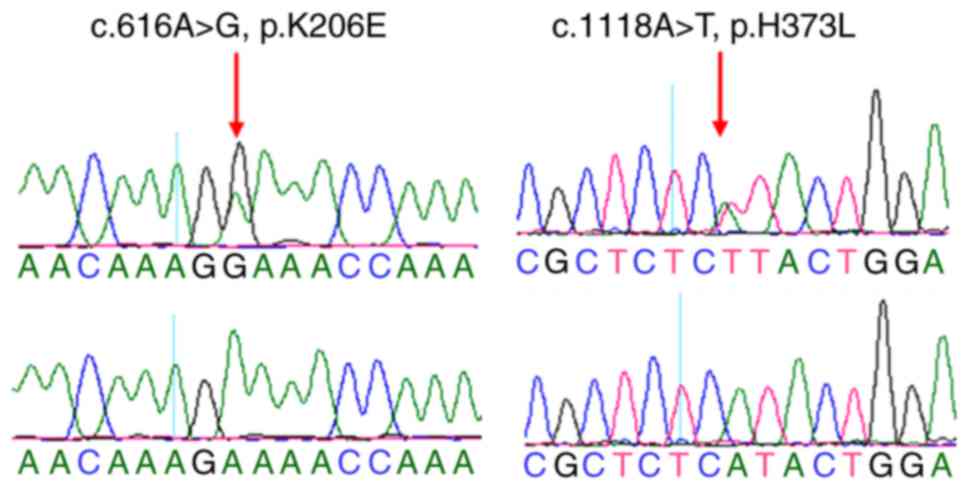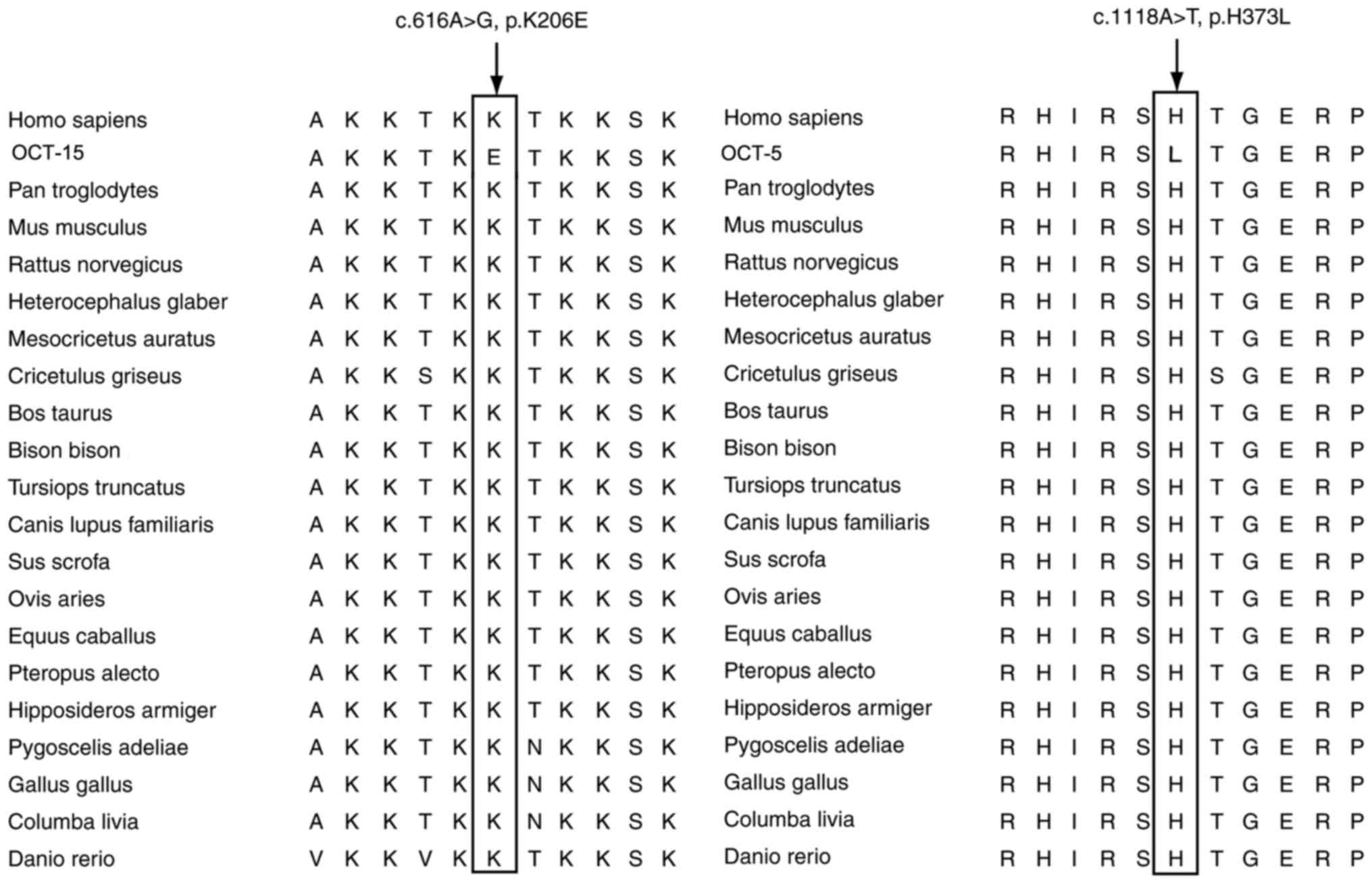|
1
|
Bedaiwy MA, Allaire C, Yong P and Alfaraj
S: Medical management of endometriosis in patients with chronic
pelvic pain. Semin Reprod Med. 35:38–53. 2017.PubMed/NCBI
|
|
2
|
Cakmak H, Seval-Celik Y, Arlier S,
Guzeloglu-Kayisli O, Schatz F, Arici A and Kayisli UA: p38
Mitogen-activated protein kinase is involved in the pathogenesis of
endometriosis by modulating inflammation, but not cell survival.
Reprod Sci. 25:587–597. 2018. View Article : Google Scholar : PubMed/NCBI
|
|
3
|
Exacoustos C, Zupi E and Piccione E:
Ultrasound Imaging for ovarian and deep infiltrating endometriosis.
Semin Reprod Med. 35:5–24. 2017. View Article : Google Scholar : PubMed/NCBI
|
|
4
|
Gordts S, Koninckx P and Brosens I:
Pathogenesis of deep endometriosis. Fertil Steril. 108(872–885):
e12017.PubMed/NCBI
|
|
5
|
Tanbo T and Fedorcsak P:
Endometriosis-associated infertility: Aspects of pathophysiological
mechanisms and treatment options. Acta Obstet Gynecol Scand.
96:659–667. 2017. View Article : Google Scholar : PubMed/NCBI
|
|
6
|
Chui MH, Wang TL and Shih IM:
Endometriosis: Benign, malignant, or something in between?
Oncotarget. 8:78263–78264. 2017. View Article : Google Scholar : PubMed/NCBI
|
|
7
|
Schwartz Kohl AS, Wölfler MM, Mitter V,
Rauchfuss M, Haeberlin F, Eberhard M, von Orelli S, Imthurn B,
Imesch P, Fink D and Leeners B: Endometriosis, especially mild
disease: A risk factor for miscarriages. Fertil Steril.
108(806–814): e22017.
|
|
8
|
Uimari O, Rahmioglu N, Nyholt DR, Vincent
K, Missmer SA, Becker C, Morris AP, Montgomery GW and Zondervan KT:
Genome-wide genetic analyses highlight mitogen-activated protein
kinase (MAPK) signaling in the pathogenesis of endometriosis. Hum
Reprod. 32:780–793. 2017. View Article : Google Scholar : PubMed/NCBI
|
|
9
|
Burghaus S, Fasching PA, Häberle L, Rübner
M, Büchner K, Blum S, Engel A, Ekici AB, Hartmann A, Hein A, et al:
Genetic risk factors for ovarian cancer and their role for
endometriosis risk. Gynecol Oncol. 145:142–147. 2017. View Article : Google Scholar : PubMed/NCBI
|
|
10
|
Matalliotakis IM, Arici A, Cakmak H,
Goumenou AG, Koumantakis G and Mahutte NG: Familial aggregation of
endometriosis in the Yale series. Arch Gynecol Obstet. 278:507–511.
2008. View Article : Google Scholar : PubMed/NCBI
|
|
11
|
McLeod BS and Retzloff MG: Epidemiology of
endometriosis: An assessment of risk factors. Clin Obstet Gynecol.
53:389–396. 2010. View Article : Google Scholar : PubMed/NCBI
|
|
12
|
Wiegand KC, Shah SP, Al-Agha OM, Zhao Y,
Tse K, Zeng T, Senz J, McConechy MK, Anglesio MS, Kalloger SE, et
al: ARID1A mutations in endometriosis-associated ovarian
carcinomas. N Engl J Med. 363:1532–1543. 2010. View Article : Google Scholar : PubMed/NCBI
|
|
13
|
Wang Y, Mang M, Wang Y, Wang L, Klein R,
Kong B and Zheng W: Tubal origin of ovarian endometriosis and clear
cell and endometrioid carcinoma. Am J Cancer Res. 5:869–879.
2015.PubMed/NCBI
|
|
14
|
Cochrane DR, Tessier-Cloutier B, Lawrence
KM, Nazeran T, Karnezis AN, Salamanca C, Cheng AS, McAlpine JN,
Hoang LN, Gilks CB and Huntsman DG: Clear cell and endometrioid
carcinomas: Are their differences attributable to distinct cells of
origin? J Pathol. 243:26–36. 2017. View Article : Google Scholar : PubMed/NCBI
|
|
15
|
Anglesio MS, Papadopoulos N, Ayhan A,
Nazeran TM, Noë M, Horlings HM, Lum A, Jones S, Senz J, Seckin T,
et al: Cancer-associated mutations in endometriosis without cancer.
N Engl J Med. 376:1835–1848. 2017. View Article : Google Scholar : PubMed/NCBI
|
|
16
|
Vestergaard AL, Thorup K, Knudsen UB, Munk
T, Rosbach H, Poulsen JB, Guldberg P and Martensen PM: Oncogenic
events associated with endometrial and ovarian cancers are rare in
endometriosis. Mol Hum Reprod. 17:758–761. 2011. View Article : Google Scholar : PubMed/NCBI
|
|
17
|
Hansen AS, Pustova I, Cattoglio C, Tjian R
and Darzacq X: CTCF and cohesin regulate chromatin loop stability
with distinct dynamics. Elife. 6:pii: e25776. 2017. View Article : Google Scholar
|
|
18
|
Pérez-García A, Marina-Zárate E,
Álvarez-Prado ÁF, Ligos JM, Galjart N and Ramiro AR: CTCF
orchestrates the germinal centre transcriptional program and
prevents premature plasma cell differentiation. Nat Commun.
8:160672017. View Article : Google Scholar : PubMed/NCBI
|
|
19
|
Marshall AD, Bailey CG, Champ K, Vellozzi
M, O'Young P, Metierre C, Feng Y, Thoeng A, Richards AM, Schmitz U,
et al: CTCF genetic alterations in endometrial carcinoma are
pro-tumorigenic. Oncogene. 36:4100–4110. 2017. View Article : Google Scholar : PubMed/NCBI
|
|
20
|
Cancer Genome Atlas Research Network, .
Kandoth C, Schultz N, Cherniack AD, Akbani R, Liu Y, Shen H,
Robertson AG, Pashtan I, Shen R, et al: Integrated genomic
characterization of endometrial carcinoma. Nature. 497:67–73. 2013.
View Article : Google Scholar : PubMed/NCBI
|
|
21
|
Walker CJ, Miranda MA, O'Hern MJ, McElroy
JP, Coombes KR, Bundschuh R, Cohn DE, Mutch DG and Goodfellow PJ:
Patterns of CTCF and ZFHX3 mutation and associated outcomes in
endometrial cancer. J Natl Cancer Inst. 107:pii: djv249. 2015.
View Article : Google Scholar
|
|
22
|
Li X, Zhang Y, Zhao L, Wang L, Wu Z, Mei
Q, Nie J, Li X, Li Y, Fu X, et al: Whole-exome sequencing of
endometriosis identifies frequent alterations in genes involved in
cell adhesion and chromatin-remodeling complexes. Hum Mol Genet.
23:6008–6021. 2014. View Article : Google Scholar : PubMed/NCBI
|
|
23
|
Zondervan KT, Rahmioglu N, Morris AP,
Nyholt DR, Montgomery GW, Becker CM and Missmer SA: Beyond
endometriosis Genome-wide association study: From genomics to
phenomics to the patient. Semin Reprod Med. 34:242–254. 2016.
View Article : Google Scholar : PubMed/NCBI
|
|
24
|
Montgomery GW and Giudice LC: New lessons
about Endometriosis-somatic mutations and disease heterogeneity. N
Engl J Med. 376:1881–1882. 2017. View Article : Google Scholar : PubMed/NCBI
|
|
25
|
Wu J, Zou Y, Luo Y, Guo JB, Liu FY, Zhou
JY, Zhang ZY, Wan L and Huang OP: Prevalence and clinical
significance of mediator complex subunit 12 mutations in 362 Han
Chinese samples with uterine leiomyoma. Oncol Lett. 14:47–54. 2017.
View Article : Google Scholar : PubMed/NCBI
|
|
26
|
Tamura K, Dudley J, Nei M and Kumar S:
MEGA4: Molecular evolutionary genetics analysis (MEGA) software
version 4.0. Mol Biol Evol. 24:1596–1599. 2007. View Article : Google Scholar : PubMed/NCBI
|
|
27
|
Schwarz JM, Cooper DN, Schuelke M and
Seelow D: MutationTaster2: Mutation prediction for the
deep-sequencing age. Nat Methods. 11:361–362. 2014. View Article : Google Scholar : PubMed/NCBI
|
|
28
|
Adzhubei IA, Schmidt S, Peshkin L,
Ramensky VE, Gerasimova A, Bork P, Kondrashov AS and Sunyaev SR: A
method and server for predicting damaging missense mutations. Nat
Methods. 7:248–249. 2010. View Article : Google Scholar : PubMed/NCBI
|
|
29
|
Zighelboim I, Mutch DG, Knapp A, Ding L,
Xie M, Cohn DE and Goodfellow PJ: High frequency strand slippage
mutations in CTCF in MSI-positive endometrial cancers. Hum Mutat.
35:63–65. 2014. View Article : Google Scholar : PubMed/NCBI
|
|
30
|
Ohlsson R, Lobanenkov V and Klenova E:
Does CTCF mediate between nuclear organization and gene expression?
Bioessays. 32:37–50. 2010. View Article : Google Scholar : PubMed/NCBI
|
|
31
|
Bushey AM, Dorman ER and Corces VG:
Chromatin insulators: Regulatory mechanisms and epigenetic
inheritance. Mol Cell. 32:1–9. 2008. View Article : Google Scholar : PubMed/NCBI
|
|
32
|
Fujimoto A, Furuta M, Totoki Y, Tsunoda T,
Kato M, Shiraishi Y, Tanaka H, Taniguchi H, Kawakami Y, Ueno M, et
al: Whole-genome mutational landscape and characterization of
noncoding and structural mutations in liver cancer. Nat Genet.
48:500–509. 2016. View Article : Google Scholar : PubMed/NCBI
|
|
33
|
Aulmann S, Bläker H, Penzel R, Rieker RJ,
Otto HF and Sinn HP: CTCF gene mutations in invasive ductal breast
cancer. Breast Cancer Res Treat. 80:347–352. 2003. View Article : Google Scholar : PubMed/NCBI
|
|
34
|
Kuhn E, Wu RC, Guan B, Wu G, Zhang J, Wang
Y, Song L, Yuan X, Wei L, Roden RB, et al: Identification of
molecular pathway aberrations in uterine serous carcinoma by
genome-wide analyses. J Natl Cancer Inst. 104:1503–1513. 2012.
View Article : Google Scholar : PubMed/NCBI
|
|
35
|
Le Gallo M, O'Hara AJ, Rudd ML, Urick ME,
Hansen NF, O'Neil NJ, Price JC, Zhang S, England BM, Godwin AK, et
al: Exome sequencing of serous endometrial tumors identifies
recurrent somatic mutations in chromatin-remodeling and ubiquitin
ligase complex genes. Nat Genet. 44:1310–1315. 2012. View Article : Google Scholar : PubMed/NCBI
|
|
36
|
Xuan J, Yu Y, Qing T, Guo L and Shi L:
Next-generation sequencing in the clinic: Promises and challenges.
Cancer Lett. 340:284–295. 2013. View Article : Google Scholar : PubMed/NCBI
|
|
37
|
Yao YG, Ogasawara Y, Kajigaya S, Molldrem
JJ, Falcão RP, Pintão MC, McCoy JP Jr, Rizzatti EG and Young NS:
Mitochondrial DNA sequence variation in single cells from leukemia
patients. Blood. 109:756–762. 2007. View Article : Google Scholar : PubMed/NCBI
|
|
38
|
Tsiatis AC, Norris-Kirby A, Rich RG, Hafez
MJ, Gocke CD, Eshleman JR and Murphy KM: Comparison of Sanger
sequencing, pyrosequencing, and melting curve analysis for the
detection of KRAS mutations: Diagnostic and clinical implications.
J Mol Diagn. 12:425–432. 2010. View Article : Google Scholar : PubMed/NCBI
|
|
39
|
Monzon FA, Ogino S, Hammond ME, Halling
KC, Bloom KJ and Nikiforova MN: The role of KRAS mutation testing
in the management of patients with metastatic colorectal cancer.
Arch Pathol Lab Med. 133:1600–1606. 2009.PubMed/NCBI
|











